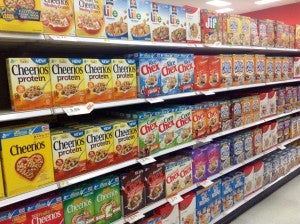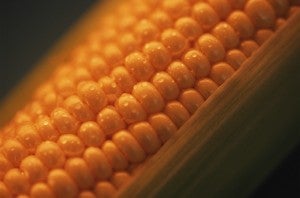Why you won’t see an eco-label on your corn flakes anytime soon

Corn affects every person in the United States.
It is grown on about 90 million acres, an area roughly the size of Montana. Corn is ubiquitous in the products we buy, from shampoo and sodas to ethanol and animal feed.
The crop also uses the majority of nitrogen fertilizer in agriculture, requiring more nitrogen than soybeans, cotton and wheat combined. Nitrogen is necessary to produce corn. But when nitrogen is over-applied, crops cannot absorb it all – and this can lead to air and water pollution.
Fortunately, figuring out ways to use nutrients more efficiently to reduce loss improves a farmer’s bottom line. It also gives them a competitive advantage, as more and more food companies are embracing sustainability and fertilizer efficiency as a way to reduce risk in their supply chains.
But how do these companies measure the sustainability of corn and report back to their customers? Corn’s supply chain is incredibly complex, meaning that food companies don’t know where the particular corn in their products came from. So, you’re not likely to see a box of cereal labeled as sustainable anytime soon since we can’t easily track bushels of corn from farm to table.
What food companies can do is help growers maximize nutrient efficiency across their sourcing regions.
By focusing on sustainability at the regional level, food companies can connect with initiatives like United Suppliers’ SUSTAIN platform to improve the fertilizer efficiency of their products at the ground level –without segregating individual bushels of corn.
Farmers plant corn seeds, and then they apply inputs such as fertilizer to help the plant grow to its maximum potential.
From seed to harvest takes about six months, and all along the way farmers make decisions about how to manage their land that can impact the sustainability and quality of the corn product. They want to use just the right amount of fertilizer to get a good harvest, reduce nutrient losses – and stay profitable.
After harvesting, tracking the life of a corn kernel gets tricky. Producers have many places to sell their grain. As a commodity, the price of corn fluctuates, and some growers may choose not to sell their harvest, but to store it on their land until prices are more favorable.
Eventually, growers sell their corn to grain elevators near their farms. Elevators aggregate and mix grain from many farmers into giant silos. After millions of kernels are co-mingled, there is no way to distinguish between Farmer Joe’s corn and Farmer Jane’s.
And then corn gets even more mixed up. The elevators sell the grain to mills, which buy from many sources and convert it into useable products – corn flour, high fructose corn syrup, ethanol or animal feed. At this point, companies purchase the products and make them into the food and everyday items we buy at the store.
Needle in a haystack
Tracking sustainability characteristics about corn through the supply chain can be incredibly difficult. Most of the environmental impacts of corn production come from grower management choices. Even if the farmer makes sustainability a priority, the grain is mixed so much in the supply chain that users of the products cannot know about the practices used on farms. So instead of tracking the corn itself, we need companies to track sustainability improvements within their supply chains.
Fortunately, there are many opportunities for companies to communicate to farmers that they’re interested in fertilizer optimization. Major retailers are asking their suppliers to encourage farmers in their growing regions to improve the efficiency of fertilizer use, a decision that can maintain or increase crop yields, save money and reduce climate and water pollution.
The emphasis is on influencing change in a sourcing region, rather than ensuring the sustainability of a specific product, such as my soda. For example, if a soda company is getting its high fructose corn syrup from a mill in northeast Iowa, it can encourage all growers in that region to use sustainable practices, even if the corn grown in that region does not end up in that company’s cans of soda.
The bottom line
Companies don’t often know where their grain comes from – but they can still act to improve the sustainability of their supply chain. By focusing on engagement with growers—whether at the county specific or more regional level—they can support efforts to use fertilizer more efficiently and build resilience into U.S. agriculture.













